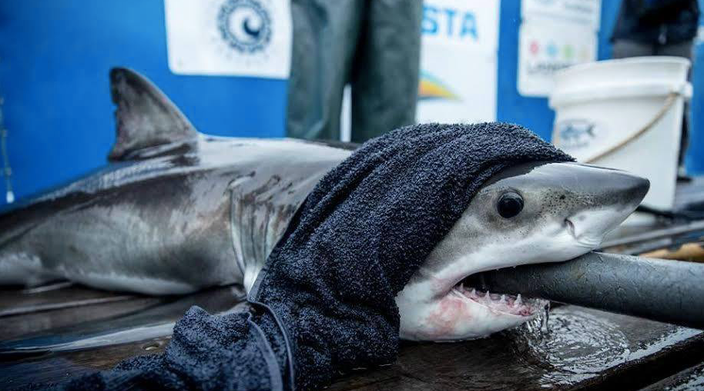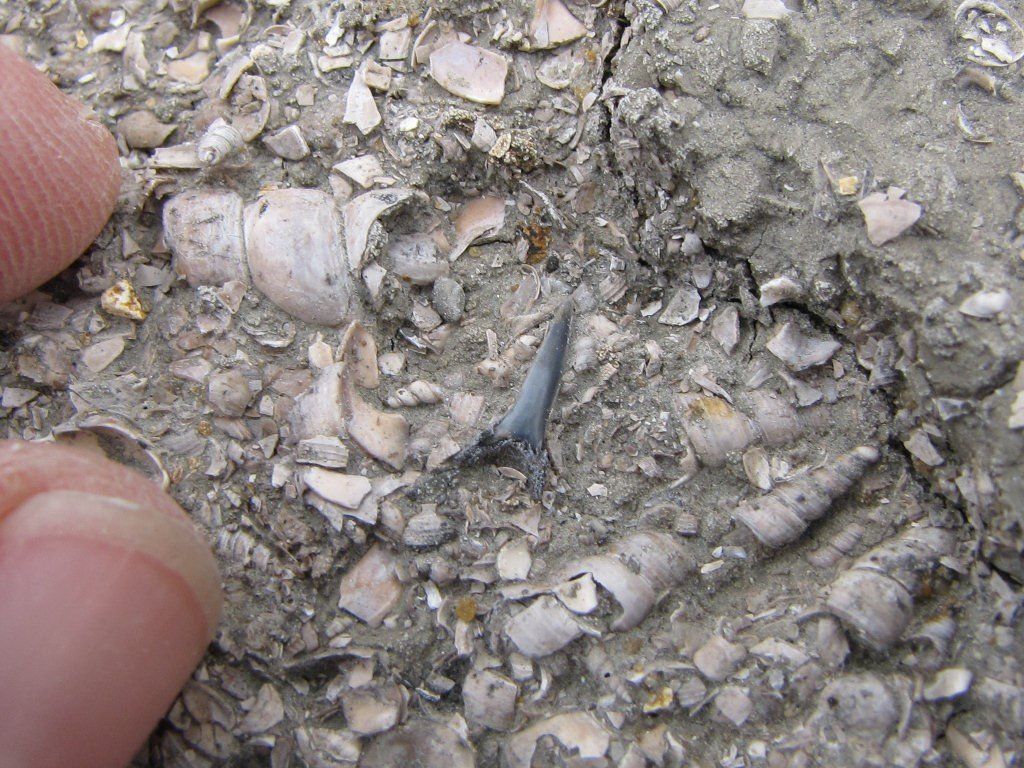BABY SHARK ♫ DOO-DOO-DO-DO-DO ♫
Sophie A. Maycock |
Great white sharks are one of the most easily recognised shark species in the world, for the most part because their impressive size makes them pretty unmistakable! Great whites are known to reach at least 6 m in length (from the snout to tip of the tail)and weigh as much as 2 tonnes.
However, great white sharks (Carcharodon carcharias) begin life as mere 1.2 m babies. Many species of sharks lay eggs (a reproductive method known as known as “
oviparity ”),but female white sharks give birth to 2 - 17 live young in each litter (known as “
vivipary ” or live-bearing) in very specific locations. White sharks live all around the world in temperate to semi-tropical oceans and they undertake large-scale migrations across ocean basins. Yet, despite this cosmopolitan distribution, they are very selective in the areas they choose to migrate to. Individual sharks return to specific locations to feed, mate and give birth to pups, which can even be as accurate as homing in on one particular bay after travelling 5,000km (a process called “
philopatry ”)(Compagno, 2001).
Great white sharks do not rear their young, and juvenile and mature sharks rarely mix. After birth, young sharks grow up in “
nursery habitats ”with other juveniles. These nurseries offer sharks (and other marine fauna) are relatively safe environment where neonates and juvenile animals can live and grow, with plentiful access to food and protection from predators (Heupel,
et al ., 2007). When young and small, the sharks are vulnerable to predation from predators, including larger sharks, and feed upon fish and squid innear-shore, shallow waters. As they grow larger (above 3 m in length), they undergo a shift in diet to also predate upon marine mammals (such as seals, dolphins and whales), at which point they may be found further offshore in the pelagic environment. Finally, when they reach a critical size (3.5 m for males and 4.8 m for females), the sharks become sexually mature and, when pregnant, the females will migrate back to the nursery habitat to birth pups of their own. A circle of life over thousands of kilometres!
As white sharks segregate my size, we can use an individual shark’s location to extrapolate the function that a certain area might have in the life-history of this species. For instance, in an area where neonate sharks and large, pregnant females are commonly found, we can assume that a habitat which is used by females for giving birth is probably not too far away (known as a “
parturition region ”). But, we can even do this if the sharks are dead! All we need is the evidence that a shark was at a particular location at a certain time.
White sharks do not have hardened skeletons (like humans, elephants, whales…), but instead have a skeleton made up of cartilage(leading to their taxonomic classification as cartilaginous fishes or “
Chondrichthyes ”). These soft skeletons rarely fossilise, but the hardened teeth often do and can be commonly found in fossil beds around the world. Great white sharks do not have milk- and adult-teeth, like humans do. Instead, they have a conveyor belt of teeth, which are constantly growing, shedding, and being replaced throughout their life, and as the shark gets bigger, so do the teeth. At their maximum size, white shark teeth may be around 7 cm from root to tip and an individual shark may have as many as 30,000 teeth over its lifetime!
Therefore, shark teeth fossils are relatively common (you can even find them at the beach sometimes!). So, we can use fossilised teeth of different sizes to learn about the distribution of sharks throughout time and where critical habitats (such as nursery areas) may have been located in the past! The deep… deep past.
Sharks first evolved around 450 million years ago(that is before the dinosaurs) and great whites have been living on our planet, absolutely unchanged, for at least 16 million years! So, when conditions are right, we can find evidence of habitats great white sharks used millions of years ago.
In a rich fossil bed in the Coquimbo formation o fChile, fossilised teeth can be found in high numbers, but what is interesting, is that this area has a high proportion of juvenile white shark teeth and large teeth from adults are rare. This suggests that at the time these teeth were shed and began the fossilisation process (during the “
Pliocene” ), this area may have been a nursery habitat. On the other hand, down the coast in Peru(at the Pisco formation), the opposite pattern is found; mostly teeth are large, adult teeth, but smaller juvenile shark teeth are rarely found. This suggests that this area was used as a foraging habitat by sub-adult and mature great white sharks approximately 2 - 5 million years ago.
We now think that the locations of white shark nursery habitats currently exist in Mexico (the Southern California Bight), SouthAfrica, Australia (at Cornet Islet and Port Stephen), the American east coast(the New York Bight), and in the Mediterranean Sea. We have not found any evidence that white sharks use South American waters as nursery habitats today, so this suggests that the locations of these critical habitats can shift or even disappear completely. We think that the nursery area in Chile may no longer be used by extant white sharks because it was considerably warmer during the Pliocene period and the area would have had higher sea surface temperatures at the time, which were favourable to juvenile white sharks. As the climate cooled over millions of years, white sharks shifted their distribution and location of nursery habitats to the pattern we see today.
It is very important to identify nursery areas because they are critical habitats to the survival of marine species, especially those which are threatened by extinction, such as the white shark. Implementing conservation legislation which protects these habitats as a priority allows the survival of a higher number of juveniles, and thus increases recruitment into the adult population. If climate change does continue as scientists predict, increasing global temperatures and subsequent rising sea surface temperatures may cause a significant shift in white shark distribution. As “
apex predators ” this can cause a “
trophic cascade ”, where other species in the marine community are also impacted, which can have a knock-on effect on the physical environment. To continue to protect these fascinating, important animals, it is important to locate and understand their critical habitats. Ifwe all work together, show our support and work hard to protect our oceans, we hope white sharks will still be found in our oceans for many, many years to come.
Compagno, L.J.V. (2001). Sharks of the world. An
annotated and illustrated catalogue of shark species to date. FAO Species
Catalogue for Fishery Purposes, Rome
, 1
:2, pages 100-107 http://www.fao.org/3/x9293e/x9293e06.pdf
Heupel, M.R., Carlson, J.K. & Simpfendorfer, C.A.
(2007). Shark nursery areas: concepts, definition, characterisation and
assumptions. Marine Ecology Press Series
, 337
, 287-297. https://www.int-res.com/articles/meps2007/337/m337p287.pdf
Villafaña, J.A., Hernandez, S., Alvarado, A., Shimada,
K., Pimiento, C., Rivadeneira, M.M. & Kriwet, J. (2020). First evidence of
a palaeo-nursery area of the great white shark. Scientific Reports
,
10:1. DOI: 10.1038/s41598-020-65101-1.


















